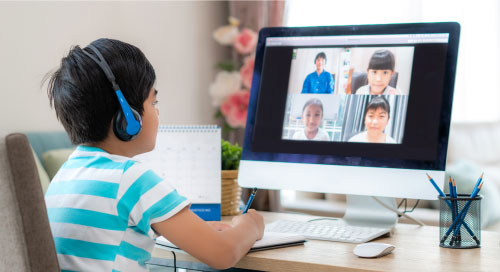New Tech Upgrades Distance Learning

When schools and colleges were suddenly forced to close their doors, they had to implement distance learning in a hurry. Though many educators were already familiar with digital tools, they have discovered new interactive capabilities that allow them to hold students’ attention throughout the school day as they complete their assignments from home.
Digital learning was already well underway before the crisis. In a 2019 Gallup survey, 65 percent of teachers said they use digital learning tools every day. A majority of teachers, principals, and administrators said digital tools are more effective than their nondigital counterparts for engaging students and personalizing instruction.
Now educators are looking for ways to improve their distance learning capabilities. Whether sharing lessons across remote campuses or engaging students in virtual classrooms, the latest remote learning solutions offer students and teachers a host of interactive features and tools that bring content to life.
Here’s how industry leaders are helping engage students through their senses, as well as their minds—bringing them closer to classmates and teachers even if they are miles away from school.
Gesture-driven Interactive Learning
Students bored with traditional lectures can instead use gestures to play interactive educational games with the Prowise touchscreen. An Intel® RealSense™ camera combines with technology in the screen to register hand, head, and body movements as students come near the screen.
But Prowise touchscreens are not just fun and games. The camera can also be used for distance learning thanks to a preinstalled Microsoft Skype app. Faraway teachers can be invited into the classroom, and at-home students can participate in lessons.
The touchscreens also house powerful Intel-based PC modules. Thus the display is actually a versatile front-of-room computer—one that supports wireless collaboration through Intel Unite®, as well as remote device management using Intel vPro® technology.
New distance learning tech brings students together, even if they are miles apart. via @insightdottech
Collaboration Tools for the Classroom
Teachers can deliver lessons, import and display Microsoft PowerPoint presentations, and set up real-time questions, polls, and other interactive displays with SMART Technologies’ online learning suite. Instead of just typing their answers into a box, students can use colorful digital inking tools or upload images.
The system integrates with Zoom and other video conferencing apps, enabling teachers to see students and gauge their reactions in real time. They can also assign pupils to teams using drag-and-drop tools that appear instantly on everyone’s screen.
SMART designed its platform to be easy for teachers to learn, and the company is currently offering free online tutorials and other resources.
Streamline and Simplify Shared Video
By tapping a touchscreen, teachers can stream a video, display a document, broadcast a lecture, or record a lesson for later distribution with the Crestron platform, which uses Intel® Xeon ® Processors and comes with its own built-in video and audio tools.
Students can connect their phones or tablets and stream video to one another in small groups, adding a new spark to teamwork. The company’s enterprise-grade collaboration platform also includes AI features that take attendance and adjust the camera angle to center people in the frame.
The platform’s cloud-based management system enables school IT administrators to remotely resolve problems with connected devices. Automated software and firmware updates reduce installation time by up to 90 percent, the company said.
Sharing from Anywhere
These are just a few of the solutions advancing the art of remote learning. Other notable examples include the ViewSonic myViewBoard. This clever digital whiteboard uses Intel Unite to enable students to participate in class activities using virtually any smartphone, notebook, or tablet—whether they are in the classroom or far away.
Or consider the Newline Interactive touchscreens, which allow students to share voice and video feeds, as well as documents, from their PCs or mobile devices. The platform includes two wide-angle cameras, allowing large groups of participants to share content and be seen.
The Evolution Continues
All of these examples show that distance learning has come a long way from the simple video broadcasts of old. By letting students and teachers see one another and interact in real time, they make online learning an engaging and vibrant experience for people of every learning style—one that will continue to improve as teachers test today’s tools and suggest new features.